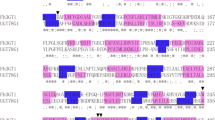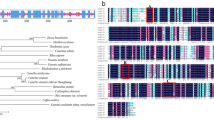Abstract
Chalcone isomerase (CHI) is one of the key enzymes in the flavonoid and anthocyanin biosynthesis pathway catalyzing the stereospecific isomerization of chalcones into their corresponding (2S)-flavanones. In this study, to investigate the role of CHI in tree peony flower coloration mechanism, a CHI gene was isolated from Paeonia suffruticosa cv. Guan Shi Mo Yu, and designated as Ps-CHI1. The cDNA sequence of Ps-CHI1 was 924 bp in full length containing an opening reading frame of 654 bp that encoded a peptide of 217 amino acids with a predicted molecular mass of 23.3 kDa and a pI of 5.0. Sequence alignment and phylogenetic analysis revealed that Ps-CHI1 shared high homology with other type I higher plant CHI proteins. Quantitative real-time PCR analysis indicated that Ps-CHI1 showed the highest transcript abundance in petals, moderate levels in sepals, low levels in leaves and carpels and the lowest levels in stamens. Ps-CHI1 was expressed at the highest level in early stage of uncolored flowers and underwent moderate decreases in expression until there was little transcription could be detected when flowers fully opened and deeply pigmented. By inserting Ps-CHI1 into tobacco (Nicotiana tabacum L.) via Agrobacterium-mediated transformation, T1 transgenic plants were obtained. Phenotypes and pigment analysis revealed that they produced up to threefold total flavonols and flavones over wild-type control, and showed a remarkable reduction in anthocyanin content and flower color intensity. These results provide theoretical deduction supporting Ps-CHI1 as an important gene involved in tree peony flower pigmentation.







Similar content being viewed by others
Abbreviations
- Bp:
-
Base pair
- CaMV:
-
Cauliflower mosaic virus
- cDNA:
-
Complementary DNA
- CHI:
-
Chalcone isomerase
- CTAB:
-
Cetyltrimethylammonium bromide
- DNase:
-
Deoxyribonuclease
- dNTP:
-
Deoxyribonucleoside 5′-triphosphate
- MS:
-
Murashige and Skoog
- EDTA:
-
Ethylenediaminetetraacetic acid
- ORF:
-
Opening reading frame
- PCR:
-
Polymerase chain reaction
- PVPP:
-
Polyvinyl polypyrrolidone
- RACE:
-
Rapid amplification of cDNA ends
- RNase:
-
Ribonuclease
- RT-PCR:
-
Reverse transcription polymerase chain reaction
- 5′-UTR:
-
5′-Untranslation region
- 3′-UTR:
-
3′-Untranslation region
References
Bradford MM (1976) A rapid and sensitive method for the quantitation of microgram quantities of protein utilizing the principle of protein-dye binding. Anal Biochem 72:248–254
Butelli E, Titta L, Giorgio M, Mock HP, Matros A, Peterek S, Schijlen EG, Hall RD, Bovy AG, Luo J, Martin C (2008) Enrichment of tomato fruit with health-promoting anthocyanins by expression of select transcription factors. Nat Biotechnol 26:1301–1308
Chang S, Puryear J, Cairney J (1993) A simple and efficient method for isolating RNA from pine trees. Plant Mol Biol Rep 11:113–116
Cheng H, Li L, Cheng S, Cao F, Wang Y, Yuan H (2011) Molecular cloning and function assay of a chalcone isomerase gene (GbCHI) from Ginkgo biloba. Plant Cell Rep 30:49–62
Forkmann G, Dangelmayr B (1980) Genetic control of chalcone isomerase activity in flowers of Dianthus caryophyllus. Biochem Genet 18:519–527
Honda C, Kotoda N, Wada M, Kondo S, Kobayashi S, Soejima J, Zhang ZL, Tsuda T, Moriguchi T (2002) Anthocyanin biosynthetic genes are coordinately expressed during red coloration in apple skin. Plant Physiol Biochem 40:955–962
Horsch RB, Fraley RT, Rogers SG, Sanders PR, Lloyd A (1985) A simple and general method for transferring genes into plants. Science 227:1229–1231
Hosoki T, Hamada M, Kando T, Moriwaki R, Inaba K (1991) Comparative study of anthocyanin in tree peony flowers. J Jpn Soc Hortic Sci 60:395–403
Hu K, Meng L, Han K, Sun Y, Dai S (2009) Isolation and expression analysis of key genes involved in anthocyanin biosynthesis of cineraria. Acta Horticult Sin 36:1013–1022
Jackson D, Roberts K, Martin C (1992) Temporal and spatial control of expression of anthocyanin biosynthetic genes in developing flowers of Antirrhinum majus. Plant J 2:425–434
Jez JM, Noel JP (2002) Reaction mechanism of chalcone isomerase. J Biol Chem 277:1361–1369
Jez JM, Bowman ME, Dixon RA, Noel JP (2000) Structure and mechanism of the evolutionarily unique plant enzyme chalcone isomerase. Nat Struct Biol 7:786–791
Kim SH, Lee JR, Hong ST, Yoo YK, An G, Kim SR (2003) Molecular cloning and analysis of anthocyanin biosynthetic genes preferentially expressed in apple skin. Plant Sci 165:403–413
Kim S, Jones R, Yoo KS, Pike LM (2004) Gold color in onions (Allium cepa): a natural mutation of the chalcone isomerase gene resulting in a premature stop codon. Mol Genet Genom 272:411–419
Koes R, Verweij W, Quattrocchio F (2005) Flavonoids: a colorful model for the regulation and evolution of biochemical pathways. Trends Plant Sci 10:236–242
Kuhn B, Forkmann G, Seyffert W (1978) Genetic control of chalcone flavanone isomerase activity in Callistephus chinensis. Planta 138:199–203
Kuhn BM, Geisler M, Bigler L, Ringli C (2011) Flavonols accumulate asymmetrically and affect auxin transport in Arabidopsis. Plant Physiol 56:585–595
Li F, Jin Z, Qu W, Zhao D, Ma F (2006) Cloning of a cDNA encoding the Saussurea medusa chalcone isomerase and its expression in transgenic tobacco. Plant Physiol Biochem 44:455–461
Li CH, Du H, Wang LS, Shu QY, Zheng YR, Xu YJ, Zhang JJ, Zhang J, Yang RZ, Ge YX (2009) Flavonoid composition and antioxidant activity of tree peony (Paeonia section Moutan) yellow flowers. J Agric Food Chem 57:8496–8503
Luceri C, Giovannelli L, Pitozzi V, Toti S, Castagnini C, Routaboul JM, Lepiniec L, Larrosa M, Dolara P (2008) Liver and colon DNA oxidative damage and gene expression profiles of rats fed Arabidopsis thaliana mutant seeds containing contrasted flavonoids. Food Chem Toxicol 46:1213–1220
Meng XC, Wang XJ (2004) Regulation of flower development and anthocyanin accumulation in Gerbera hybrida. J Hortic Sci Biotechnol 79:131–137
Moustafa E, Wong E (1967) Purification and properties of chalcone-flavanone isomerase from soya bean seed. Phytochemistry 6:625–632
Muir S, Collins G, Robinson S, Hughes S, Bovy A, De Vos C, van Tunen A, Verhoeyen M (2001) Overexpression of petunia chalcone isomerase in tomato results in fruit containing increased levels of flavonols. Nat Biotechnol 19:470–474
Nakatsuka T, Nishihara M, Mishiba K, Yamamura S (2005) Temporal expression of flavonoid biosynthesis-related genes regulates flower pigmentation in gentian plants. Plant Sci 168:1309–1318
Nishihara M, Nakatsuka T, Yamamura S (2005) Flavonoid components and flower color change in transgenic tobacco plants by suppression of chalcone isomerase gene. FEBS Lett 579:6074–6078
Shimada N, Aoki T, Sato S, Nakamura Y, Tabata S, Ayabe S (2003) A cluster of genes encodes the two types of chalcone isomerase involved in the biosynthesis of general flavonoids and legume-specific 5-deoxy(iso)flavonoids in Lotus japonicus. Plant Physiol 131:941–951
Tanaka Y, Sasaki N, Ohmiya A (2008) Biosynthesis of plant pigments: anthocyanins, betalains and carotenoids. Plant J 54:733–749
Van Tunen AJ, Koes RE, Spelt CE, Van der Krol AR, Stuitje AR, Mol JN (1988) Cloning of the two chalcone flavanone isomerase genes from Petunia hybrida: coordinate, light-regulated and differential expression of flavonoid genes. EMBO J 7:1257–1263
Wang LS, Shiraishi A, Hashimoto F, Aoki N, Shimizu K, Sakata Y (2001) Analysis of petal anthocyanins to investigate flower coloration of Zhongyuan (Chinese) and Daikon Island (Japanese) tree peony cultivars. J Plant Res 114:33–43
Wang X, Cheng CG, Sun QL, Li FW, Liu JH, Zhang CC (2005) Isolation and purification of four flavonoid constituents from the flowers of Paeonia suffruticosa by high-speed counter-current chromatography. J Chromatogr A 1075:127–131
Winkel-Shirley B (2002) Biosynthesis of flavonoids and effects of stress. Curr Opin Plant Biol 5:218–223
Yu B, Zhang D, Huang C, Qian M, Zheng X, Teng Y, Su J, Shu Q (2012) Isolation of anthocyanin biosynthetic genes in red Chinese sand pear (Pyrus pyrifolia Nakai) and their expression as affected by organ/tissue, cultivar, bagging and fruit side. Sci Hortic 136:29–37
Zhang J, Wang L, Shu Q, Liu Z, Li C, Zhang J, Wei X, Tian D (2007) Comparison of anthocyanins in non-blotches and blotches of the petals of Xibei tree peony. Sci Hortic (Amsterdam) 114:104–111
Zhang H, Liu J, Lu H, Gao S (2009) Enhanced flavonoid production in hairy root cultures of Glycyrrhiza uralensis Fisch by combining the over-expression of chalcone isomerase gene with the elicitation treatment. Plant Cell Rep 28:1205–1213
Zhang X, Allan AC, Yi Q, Chen L, Li K, Shu Q, Su J (2011) Differential gene expression analysis of Yunnan red pear, Pyrus Pyrifolia, during fruit skin coloration. Plant Mol Biol Rep 29:305–314
Zhou L, Wang Y, Peng Z (2011) Molecular characterization and expression analysis of chalcone synthase gene during flower development in tree peony (Paeonia suffruticosa). Afr J Biotechnol 10:1275–1284
Acknowledgments
This research was supported by the National High Technology Research and Development Program of China (863 Program) (2011AA10020701) and National Natural Science Foundation of China (31201654).
Author information
Authors and Affiliations
Corresponding author
Rights and permissions
About this article
Cite this article
Zhou, L., Wang, Y., Ren, L. et al. Overexpression of Ps-CHI1, a homologue of the chalcone isomerase gene from tree peony (Paeonia suffruticosa), reduces the intensity of flower pigmentation in transgenic tobacco. Plant Cell Tiss Organ Cult 116, 285–295 (2014). https://doi.org/10.1007/s11240-013-0403-2
Received:
Accepted:
Published:
Issue Date:
DOI: https://doi.org/10.1007/s11240-013-0403-2




